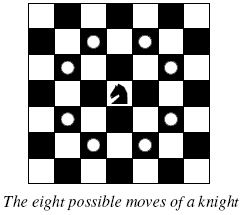A Knight's Journey
| Time Limit: 1000MS | Memory Limit: 65536K | |
| Total Submissions: 49498 | Accepted: 16787 |
Description
 Background
Background The knight is getting bored of seeing the same black and white squares again and again and has decided to make a journey
around the world. Whenever a knight moves, it is two squares in one direction and one square perpendicular to this. The world of a knight is the chessboard he is living on. Our knight lives on a chessboard that has a smaller area than a regular 8 * 8 board, but it is still rectangular. Can you help this adventurous knight to make travel plans?
Problem
Find a path such that the knight visits every square once. The knight can start and end on any square of the board.
Input
The input begins with a positive integer n in the first line. The following lines contain n test cases. Each test case consists of a single line with two positive integers p and q, such that 1 <= p * q <= 26. This represents a p * q chessboard, where p describes how many different square numbers 1, . . . , p exist, q describes how many different square letters exist. These are the first q letters of the Latin alphabet: A, . . .
Output
The output for every scenario begins with a line containing "Scenario #i:", where i is the number of the scenario starting at 1. Then print a single line containing the lexicographically first path that visits all squares of the chessboard with knight moves followed by an empty line. The path should be given on a single line by concatenating the names of the visited squares. Each square name consists of a capital letter followed by a number.
If no such path exist, you should output impossible on a single line.
If no such path exist, you should output impossible on a single line.
Sample Input
3 1 1 2 3 4 3
Sample Output
Scenario #1: A1 Scenario #2: impossible Scenario #3: A1B3C1A2B4C2A3B1C3A4B2C4
///深度搜索和回溯思想,还有字典顺序输出
///一个骑士,在p*q棋盘上以一个方向走两格,再垂直走一格的方式走遍每一个格子
#include<iostream>
#include<cstring>
using namespace std;
int vis[30][30],m,n,book[60][2];//vis用于标记走过的位置,book用于记录当前位置
int step[8][2]={{-1,-2},{1,-2},{-2,-1},{2,-1},{-2,1},{2,1},{-1,2},{1,2}};//枚举出骑士走的方向,但要注意字典序,所以方向的陈列是有顺序的
bool flag=0;//作为找到答案的标志
void dfs(int x,int y,int t)
{
if(t==(m*n))//判断是否所有格子均被遍历过
{
flag=1;
return;
}
if(flag==1) return; //因为是按照字典序进行查找的,一旦找到即为答案就直接返回
for(int i=0;i<8;i++) //遍历八个方向
{
int tx=x+step[i][0];//下一步x
int ty=y+step[i][1];//下一步y(顺序很重要不要弄错)
if(vis[tx][ty]==1)
{
vis[tx][ty]=0; //走过的格子就不能再走,所以被标记为0
book[t][0]=tx; //记录当前格子
book[t][1]=ty;
dfs(tx,ty,t+1); //继续搜索
if(flag==1) //若已找到答案,跳出循环
break;
else
vis[tx][ty]=1; //若此路不通,则将当前格子回溯(回溯过程的还原)
}
}
return;
}
void print()
{
for(int i=0;book[i][1]!=0;i++)
{
cout<<(char)(book[i][1]-1+'A')<<book[i][0];
}
cout<<endl;
return;
}
int main()
{//i不能设为全局变量
int x;
cin>>x;
for(int i=1;i<=x;i++)
{
flag=0; //flvisg用于记录是否找到走完全图的最小字典序路径
memset(vis,0,sizeof(vis));
memset(book,0,sizeof(book));
cin>>m>>n;
for(int i=1;i<=m;i++)
for(int j=1;j<=n;j++)
vis[i][j]=1; //标记图中走的地方
vis[1][1]=0;
dfs(1,1,1);//3个参数,x,y为当前位置坐标,t为已经走过的格子数
book[0][0]=1;
book[0][1]=1;
cout<<"Scenario #"<<i<<":"<<endl;
if(flag==1)
{
print();//输出结果
}
else
cout<<"impossible"<<endl;//不存在就输出impossible
cout<<endl;
}
}
























 865
865

 被折叠的 条评论
为什么被折叠?
被折叠的 条评论
为什么被折叠?








